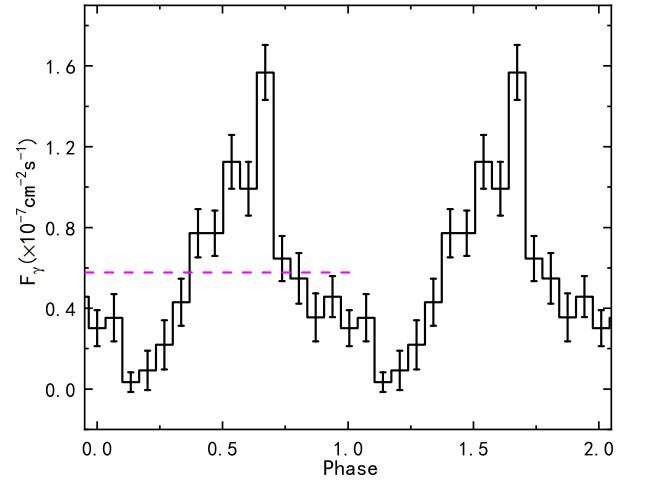May 16, 2022 report
Quasi-periodic oscillation detected in blazar PKS 0405-385

By analyzing the historical light curve of blazar PKS 0405-385 from NASA's Fermi spacecraft, Chinese astronomers have detected quasi-periodic oscillation from this source. The discovery, presented in a paper published May 5 on arXiv.org, could shed more light on the nature and behavior of this blazar.
Blazars are very compact quasars associated with supermassive black holes (SMBHs) at the centers of active, giant elliptical galaxies. They belong to a larger group of active galaxies that host active galactic nuclei (AGN), and are the most numerous extragalactic gamma-ray sources. Their characteristic features are relativistic jets pointed almost exactly toward the Earth.
Based on their optical emission properties, astronomers divide blazars into two classes: flat-spectrum radio quasars (FSRQs) that feature prominent and broad optical emission lines, and BL Lacertae objects (BL Lacs) that do not.
When X-ray light from astronomical objects flickers about certain frequencies, the behavior is known as quasi-periodic oscillations (QPOs). Although many questions about the phenomenon of QPOs remain unanswered, it is believed that they occur when X-rays are emitted near the inner edge of an accretion disk in which gas swirls onto a compact object, for instance, a neutron star or a black hole.
QPOs have been also observed in the gamma-ray emission from blazars. To date, gamma-ray QPOs in more than 20 blazars have been reported based on analyses of the data from Fermi's Large Area Telescope (LAT). Given that the cause of gamma-ray QPOs is still unclear, it is important to detect new blazars exhibiting these oscillations in the gamma-ray regime and to investigate such sources.
Now, based on the LAT data, a team of astronomers led by Yunlu Gong of Yunnan University in China reports the finding of quasi-period behavior in the gamma-ray light curve of PKS 0405-385 (also known as 4FGL J0407.0-3826)—an FSRQ at a redshift of 1.285.
"We dealt with and analyzed the long-term Fermi-LAT gamma-ray observation data of blazar PKS 0405-385 during 2008–2021 (∼13.2 years), and the results indicate that a highly probable quasi-periodic behavior of ∼2.8 years appears in the whole light curve," the researchers wrote in the paper.
Given that the temporal coverage of high-energy gamma-ray turned out to be longer than that of the optical band, the team adopted the periodic timescale of approximately 2.8 years as the final result. It was added that the detected QPO behavior should be longer than the gamma-ray light curve duration.
Moreover, the astronomers conducted a QPO analysis in the G-band light curve (between October 2014 and October 2021) and found that the results are consistent with the periodic detection in gamma-rays. This, according to the authors of the paper, suggests that the optical emission is radiated by an electron population same as the gamma-ray emission.
Trying to find a possible mechanism behind the observed quasi-periodic behavior in PKS 0405-385, the team assumes that it may be either a helical motion within the blazar's jet or by the presence of a binary SMBH.
"QPO-like flux modulations might be related to a geometrical scenario with the relativistic motion of the enhanced emission (or blobs) along the helical path of a jet. ...we also consider a supermassive black hole binary (SMBHB) system to explain the long-term periodic temporal signals," the researchers concluded.
More information: Yunlu Gong et al, Quasi-periodic behaviour in the γ-ray light curve of the blazar PKS 0405-385. arXiv:2205.02402v1 [astro-ph.HE], arxiv.org/abs/2205.02402
© 2022 Science X Network





















